 Improved query algorithm.
Improved query algorithm.
Developed code for improved 3D surface query performance. Query function allows use of arbitrary clipping planes (in addition to the parallelepiped view volume) and multiple surfaces at variable resolutions, each with a unique mask.
The basic algorithm is as follows:
- transform selected point on view plane to a view ray
- intersect view ray with convex polyhedron defined by the intersection of the parallelepiped view region with any user defined clipping planes.
- if ray enters this polyhedron, trace ray to find any intersections with visible (unmasked) parts of any surfaces
Note: View ray is traced to find intersection with surface by following the projection, or "shadow" of the ray along each polygon of the surface until the shadow passes above the view ray (when viewing from above the surface). The previous implementation traced the view ray itself, until a point below the surface was found and then used binary recursion to pinpoint the intersection. Sharp peaks and spikes were easily missed and the selection of the inital "step" down the view ray was critical and needed to be adjusted for various data ranges and exaggerations. The new strategy results in faster point selection and an exact intersection. - choose closest intersection to viewer (or return an ordered list)
- query the database (data sources for color and terrain) directly using geographic coordinate of intersection(s).
Such point-on-surface functionality is useful for 3D data querying, setting center of view, placing geographic objects or scales, and setting center of rotation for vector transformations.
 Relative scaling.
Relative scaling.
Multiple surfaces are quite useful to visualize boundaries of layers. For example, surfaces may be created that represent soil horizons so that thickness of layers may be displayed. This presents a technical challenge in terms of dimensional scale. To study differences between two similar surfaces, we use a scaled difference approach where only the spatial distance between surfaces is exaggerated, maintaining correct surface intersections. In other words, one or more surfaces are scaled relative to a base surface. This concept of a base surface (e.g., bedrock or surface terrain in soil studies) has been integrated within visualization tools to make it easier to experiment with selection of the base surface. Similarly, 3D volume data from orthogonal regions may be warped to lie along a (possibly exaggerated) base surface, to explore the effect of terrain on the volumetric feature being modeled.
Volume visualization has been implemented on top of the new GRASS "grid3" data access library, resulting in the two programs r3.mkdspf and r3.showdspf. These programs will be combined and incorporated into the primary visualization tool, NVIZ, which has been ported to use the OpenGL graphics library standard. Use of the grid3 library should allow us to resample volume data on the fly, enabling more interactive volume exploration. The following volume visualization methods will be incorporated:
- isosurfaces - currently precomputed by r3.mkdspf and displayed by r3.showdspf, will be computed as needed at selectable resolution and for smaller subregions and displayed within NVIZ.
- fence diagrams - currently available for multiple surfaces within NVIZ and for volume data using r3.showdspf, will be integrated within NVIZ.
- volume rendering - will be implemented using 3D texture extension to OpenGL and optimized volume slicing.

 sites
sites movie
movie  land
use
land
use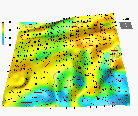 hor 1
hor 1 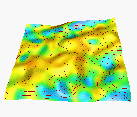 hor 3
hor 3 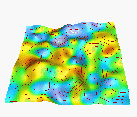 hor 5
hor 5 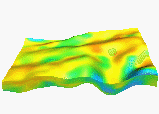 y=100
y=100 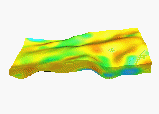 y=140
y=140 
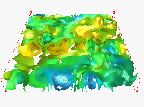 movie
movie 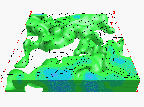 acid
acid 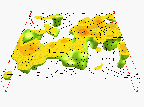 neutral
neutral  slicing
slicing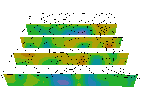 fence
diagram
fence
diagram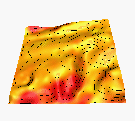

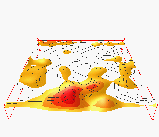 isosurfaces
isosurfaces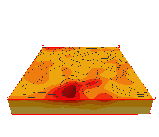 box-movie
box-movie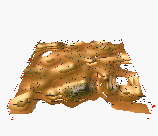 isosurfaces
isosurfaces fence
diagram
fence
diagram isosurfaces
isosurfaces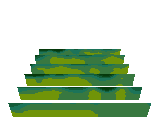 fence
diagram
fence
diagram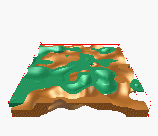 optimal
Kc,Pc
optimal
Kc,Pc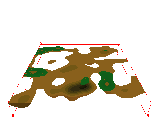 surplus
Kc,Pc
surplus
Kc,Pc isosurfaces
isosurfaces fence
diagram
fence
diagram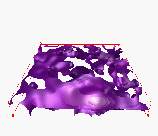 isosurfaces
isosurfaces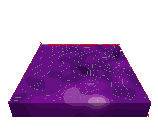 movie
movie


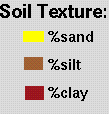 fractions
at sampling sites
fractions
at sampling sites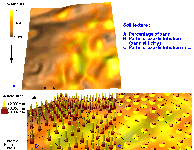 sand
[%]
sand
[%] clay
[%]
clay
[%]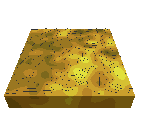 clay
[%]
clay
[%]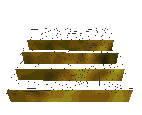 clay
[%]
clay
[%] high%
high% low[%]
low[%]
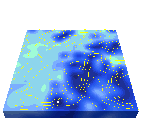

 GMSL Modeling & Visualization
GMSL Modeling & Visualization